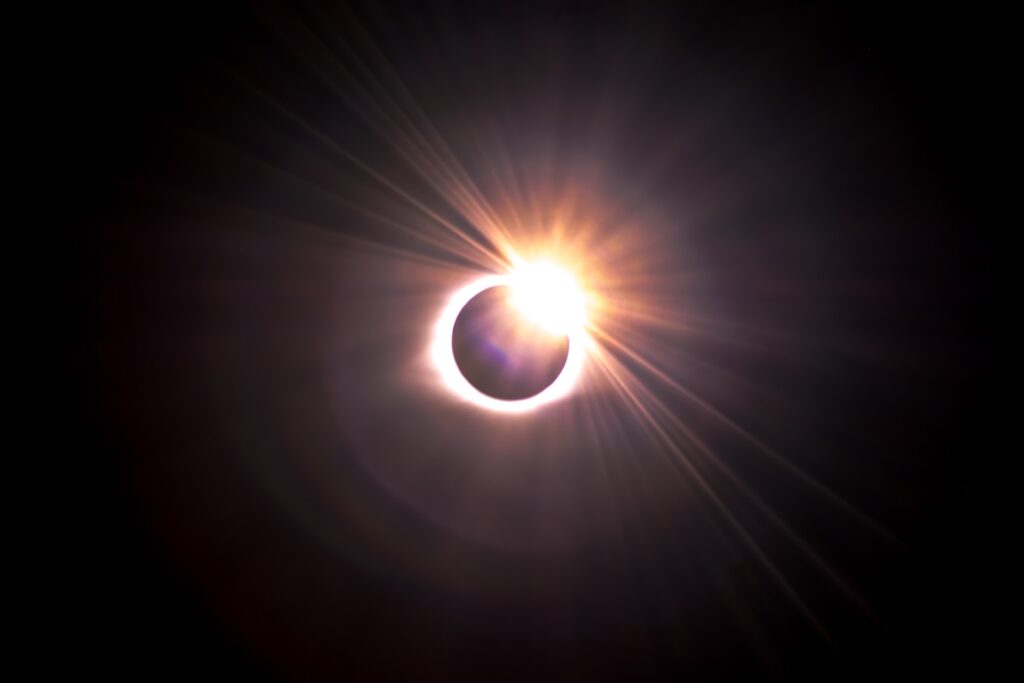The universe presents us with breathtaking spectacles, and one of the most mesmerizing events is the solar eclipse. A solar e-clipse occurs when the Moon passes between the Sun and the Earth, casting its shadow upon our planet. This cosmic alignment grants us a glimpse of nature’s grandeur.
What is a Solar Eclipse?
A solar e-clipse is a celestial event in which the Moon obscures the Sun, causing a temporary darkening of the sky. It is a captivating dance between three celestial bodies: the Sun, the Moon, and the Earth. When their paths align perfectly, a solar eclipse occurs, captivating observers with its ethereal beauty.
Types of Solar Eclipses
Partial Solar Eclipse: A partial solar e-clipse occurs when the Moon only partially covers the Sun’s disk, creating a mesmerizing crescent shape in the sky. While it may not offer the full splendor of a total solar eclipse, a partial eclipse still showcases the harmonious interplay of celestial bodies.
Annular Solar Eclipse: In an annular solar eclipse, the Moon aligns with the Sun and Earth, but its apparent size is smaller than the Sun. As a result, a thin ring of sunlight, known as an annulus, surrounds the dark silhouette of the Moon. This creates a striking visual spectacle, often referred to as the “ring of fire.”
Total Solar Eclipse: The total solar e-clipse is the pinnacle of this celestial performance. It occurs when the Moon perfectly aligns with the Sun and Earth, completely obscuring the Sun’s disk. The sky darkens, revealing the Sun’s ethereal corona, a shimmering halo of plasma. The experience of totality is awe-inspiring, leaving observers in a state of profound wonder.
Important Terminology
To navigate the world of solar eclipses, it’s essential to understand some key terms:
- Umbra: The darkest, central region of a shadow, where the light source is completely blocked.
- Penumbra: The partially shaded region surrounding the umbra, characterized by partial blocking of the light source.
- Path of Totality: The narrow track on the Earth’s surface where a total solar eclipse is visible.
- Eclipse Duration: The length of time the total or partial eclipse lasts in a given location.
Understanding these terms will enhance your comprehension and appreciation of the solar eclipse phenomenon.
Historical Significance of Solar Eclipses
Throughout history, solar e-clipses have held profound cultural and scientific significance. Ancient civilizations, such as the Egyptians and Mayans, believed that eclipses signified divine events or omens. The scientific community has also made groundbreaking discoveries during solar eclipses, such as confirming Einstein’s theory of general relativity during the total solar eclipse of 1919.
Safety Precautions during a Solar Eclipse
While solar e-clipse are captivating, it’s crucial to prioritize safety when observing them. Staring directly at the Sun during an eclipse can cause severe eye damage. To protect your eyes, always use specially designed solar filters or eclipse glasses. Additionally, various indirect viewing methods allow you to witness the eclipse safely without direct eye contact.
Best Places to Observe a Solar Eclipse
Eclipse chasers travel the globe to witness the awe-inspiring beauty of a solar eclipse. From the deserts of Chile to the icy landscapes of Antarctica, there are numerous destinations that offer optimal viewing conditions. The Great American Eclipse of 2017 attracted millions of observers across the United States, highlighting the widespread fascination with this celestial spectacle.
Notable Solar Eclipses in History
Certain solar eclipses have etched their mark in history, leaving a lasting impact on scientific discoveries and cultural narratives. The total solar e-clipse of 1919 played a pivotal role in confirming Einstein’s theory of general relativity. Similarly, the Great American Eclipse of 2017 captivated the world with its grandeur, uniting communities in a shared astronomical experience.
Future Solar Eclipses to Look Forward To
As celestial bodies continue their intricate dance, future solar eclipses are waiting to mesmerize humanity. From the total solar eclipse in Antarctica to the annular eclipse in Africa, there are numerous upcoming events that eclipse enthusiasts can anticipate. Mark your calendars and prepare for celestial wonders.
Common Misconceptions about Solar Eclipses
Solar eclipses have long been surrounded by myths and misconceptions. Superstitions about the harmful effects of eclipses on pregnant women or the need to avoid specific activities during an eclipse persist in some cultures. Debunking these misconceptions and understanding the scientific realities of eclipses promotes accurate knowledge and appreciation of this natural phenomenon.
Conclusion
A solar e-clipse is a mesmerizing celestial event that unites humanity in wonder and awe. From the interplay of celestial bodies to the cultural significance and scientific discoveries associated with eclipses, these phenomena continue to inspire and captivate us. As you gaze upon the darkening sky during a solar eclipse, take a moment to appreciate the beauty and grandeur of the cosmos.

